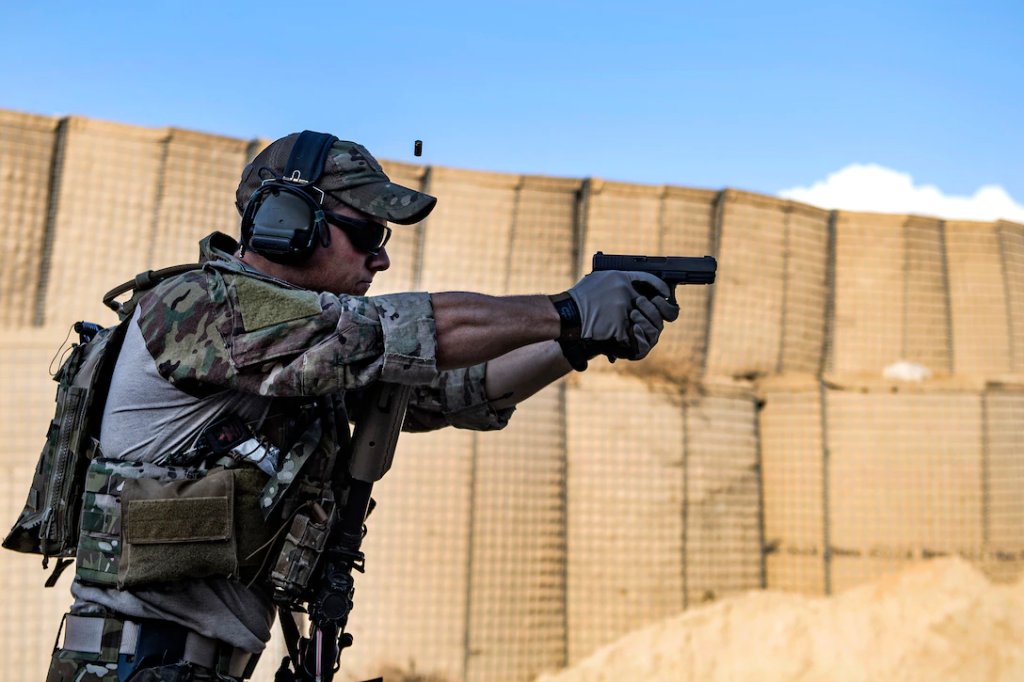Glock pistols have become the standard that modern handguns are measured against. The polymer-framed, striker-fired design has served as the inspiration for the most popular handguns on the civilian, law enforcement, and military markets. Even the military’s newest official sidearm, the M17/M18 MHS from Sig Sauer, utilizes many of the design principles used in the original Glock from the 1980s.

Despite the standardization of the M17/M18 across the military, Special Operations Command has elected to standardize the Glock 19 as its handgun of choice. From Navy SEALs to Green Berets, the Special Operations community overwhelmingly prefers the original Austrian design. However, this wasn’t always the case. It took some clever requirement writing on the part of Army Special Forces to get the Glock into SOCOM.
Adopted in 1985, the Beretta M9 was the primary sidearm of the U.S. military through most of the War on Terror. Many warfighters complained about the anemic 9mm round and its lack of stopping power compared to the legendary M1911 with its .45 ACP cartridge. Moreover, its metal slide and frame meant increased weight having to be carried. While a few ounces might not seem like much, over long distance, every ounce matters.

By the early 2000s, Glock had made a name for itself in the civilian competition and law enforcement communities as well as foreign militaries. The lightweight and simple handguns were outclassing the traditional all-metal guns and proving that polymer was the way forward. As younger generations joined Army Special Forces through the 18X program, they brought with them the desire to arm operators with Glocks. The elite Delta Force adopted the Glock 22 which further increased the demand for Glocks in Special Forces. However, even Special Forces has to answer to Big Army and purchasing a new combat handgun was out of the question.
However, Special Forces got creative with their mission requirements in order to get Glocks in their armories. While a full-size combat handgun like the Glock 17 or 34 was too similar to the M9, Special Forces lacked a concealable handgun. This deficiency was identified early in the War on Terror as operators found themselves needing a compact pistol to carry while conducting operations in civilian clothes. In the mid 2000s, Special Forces wrote a requirement for a concealable handgun that, for all intents and purposes, was worded specifically for the Glock 19.
While the compact Glock 19 wasn’t as optimal for the heavy fighting going on in Iraq and Afghanistan as the larger 17 or 34, it was the only way for Special Forces to get their hands on a Glock. Of course, the pistol passed the Special Operations testing and evaluation and it was adopted as the compact pistol of Special Forces. However, this meant that it was not issued en masse. Rather, only certain teams or specific team members would be issued the new Glocks based on their mission. With not enough Glocks to go around, ODAs often traded off their Glocks to deploying teams and reserved their M9s for stateside use.
In 2016, Special Operations Command adopted the Glock 19 outright. This meant that SOCOM units in other branches could acquire the polymer pistol and that Army Special Forces could issue it to all team members. Two years later, SOCOM expanded its modern pistol standardization with the adoption of the Trijicon RMR Type 2 red dot sight. This widespread adoption is due in large part to the testing and fielding of the Glock 19 by Army Special Forces.
This roundabout style of acquisitions is not unique to the Army. In 2011, the Marine Corps adopted the Heckler & Koch HK416 as the M27 Infantry Automatic Rifle to replace the M249 Squad Automatic Weapon. However, in 2018, the Corps announced that it would procure 11,000 M27s to be the standard rifle of the Marine Corps infantry, replacing the M4.




